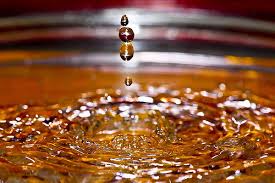The liquid state of the substance consists of a certain volume, but it has no well-defined shape and unlike the solid state, it takes the container’s shape. Contrary to the gaseous state, the liquid doesn’t occupy the complete volume of the container if in case its volume is greater than liquid’s volume.
Placed at a molecular level, molecules’ arrangement is random, in contrast to the solid state in which the molecules are periodic and regular. In the liquid state, the molecules in a liquid consisting of translational motions similar to that in the gaseous state. However, there’s a quick inter-molecular ordering or structure.
All liquids show the following characteristics:
- Strong intermolecular force: In a liquid, the intermolecular force is stronger than gas and has weaker properties than a solid. Between molecules, there’s a strong force of the interaction which is due to lesser space shared between them at a molecular level.
- Fixed density and volume: Liquid consists of a certain amount. Unlike the gases, they occupy a definite space, because of their low space amongst the molecules. Under normal physical conditions, liquid’s molecule infrequently separate from each other. Liquids are not only denser than gases, although they are even less compressible than gases.
- Shapeless and free flowing: liquids acquire the shape of the container in which they are stocked. Because of the free-flow of molecules which move over each other, fluid presumes the flowing characteristics too.

In normal conditions of pressure, temperature, and volume fluids usually show the above characteristics. When the physical condition alters, then the original character of the fluid even experience drastic changes. Besides the above characteristics, fluids also display the following properties:
- Vapor pressure
- Boiling Point
- Surface tension
- Viscosity
- Viscosity coefficient
- Physical Changes effect in Viscosity
- Temperature effect
Viscosity
Liquid’s viscosity is a measure of inefficiency to flow, and it’s measured in SI units, N s m-2 or P (poise), or cP (centipoise).
Where,
1 P = 0.1 N s m-2
1 cP = 0.001 N s m-2
Today, viscometers are also used for measuring viscosity.
The water’s viscosity is dependent on the temperature. At 293 K (20 degree-celsius), water viscosity is 1.002 cP. As the temperature increases, its viscosity decreases:
The viscosity of Water as Function Temperature
| Temperature
/°C |
Viscosity
/cP |
| 20 | 1.002 |
| 40 | 0.653 |
| 60 | 0.467 |
| 80 | 0.355 |
| 100 | 0.282 |
| Substance | Surface Tension (× 10−3J/m2) | Viscosity (mPa•s) | Vapor Pressure (mmHg) | Normal Boiling Point (°C) |
| Organic Compounds | ||||
| diethyl ether | 17 | 0.22 | 531 | 34.6 |
| n-hexane | 18 | 0.30 | 149 | 68.7 |
| acetone | 23 | 0.31 | 227 | 56.5 |
| ethanol | 22 | 1.07 | 59 | 78.3 |
| ethylene glycol | 48 | 16.1 | ~0.08 | 198.9 |
| Liquid Elements | ||||
| bromine | 41 | 0.94 | 218 | 58.8 |
| mercury | 486 | 1.53 | 0.0020 | 357 |
| Water | ||||
| 0°C | 75.6 | 1.79 | 4.6 | — |
| 20°C | 72.8 | 1.00 | 17.5 | — |
| 60°C | 66.2 | 0.47 | 149 | — |
| 100°C | 58.9 | 0.28 | 760 | — |
By adding detergents and soaps, which disturb intermolecular attraction between neighboring water molecules can decrease water’s surface tension. As they affect the properties of the surface of soaps, liquids, and detergents, which are called surface-active surfactants or agents.